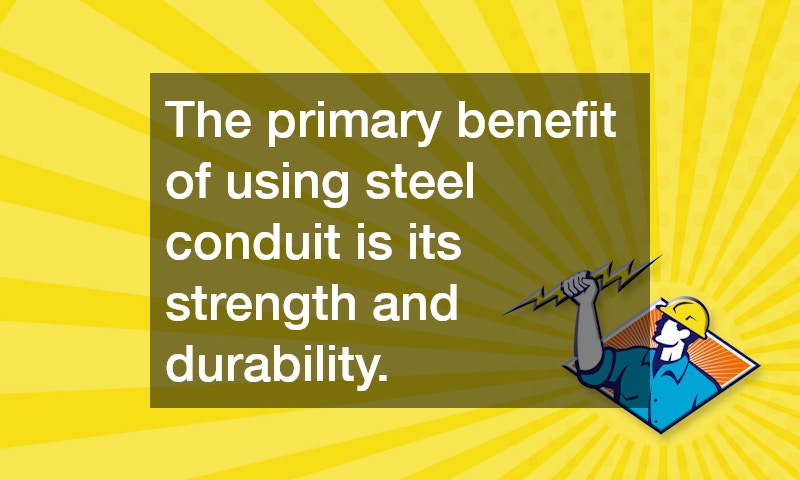
Steel conduit is a type of rigid tubing used in electrical wiring to protect wires from physical damage and environmental conditions. These conduits, made of high-quality steel, are commonly used in industrial and commercial applications due to their robustness. Available in various forms such as electrical metallic tubing (EMT), intermediate metal conduit (IMC), and rigid metal conduit (RMC), steel conduit is essential for ensuring the safety of electrical installations.
The primary benefit of using steel conduit is its strength and durability. Unlike plastic or flexible conduits, steel can withstand significant impact, making it ideal in areas where mechanical protection is crucial. Moreover, the rigidity of steel conduits ensures that the electrical wires inside remain intact, even in challenging environmental conditions.
Another key advantage of steel conduit is its ability to provide electromagnetic interference (EMI) shielding. For sensitive electronic installations, minimizing interference is pivotal for optimal performance. Steel conduits effectively block out EMI, which can disrupt or damage electrical circuits. They are particularly beneficial in high-density areas, where multiple power sources and electronic devices are in close proximity.
Choosing the Right Type of Steel Conduit
When purchasing steel conduit, one of the critical factors to consider is the specific application it will be used for. EMTs are lightweight and thinner than other types, making them suitable for indoor use and where bending is required. On the other hand, IMC and RMC are thicker and more robust, ideal for outdoor or industrial uses where high resistance to impact and corrosion is necessary.
The environment in which the conduit will be placed plays a significant role in the selection process. For environments subject to moisture or chemicals, selecting a conduit with corrosion-resistant coatings is essential. Galvanized steel conduit, for example, provides an additional layer of protection, preventing rust and extending the conduit’s lifespan in harsh conditions.
Another consideration is the installation requirements and local building codes. Some jurisdictions have stringent regulations governing the type of conduit used in certain constructions. It’s vital to consult these codes before purchase to ensure compliance and avoid costly replacements or modifications later on.
Cost Considerations for Steel Conduit
Budgeting is a critical aspect when purchasing steel conduit, as prices can vary depending on the type and additional treatments, such as galvanization. Comparing prices from different manufacturers can be beneficial, but it is essential to ensure that the quality of the conduit meets the necessary standards for your project. Often, investing a little more upfront can save money in long-term maintenance and replacement costs.
Installation costs should also be factored into the budget. While steel conduit may initially seem more costly than alternatives like plastic or flexible conduit, its durability and low maintenance can reduce overall expenses. Professional installation is often recommended to ensure the conduit is properly fitted and adheres to safety regulations, which is another expense to consider.
It’s also wise to consider the total lifecycle cost of the conduit. Steel conduits have a long lifespan, often exceeding the lifespan of the building itself, providing excellent value for money. Additionally, any scrap steel conduit can typically be recycled, helping to offset some costs and support environmental sustainability efforts.
Benefits of Steel Conduit
Steel conduit’s most significant benefit is its exceptional durability, making it a reliable choice for long-term installation. Its sturdy construction prevents damage to encased wires from environmental elements or physical impact. In areas prone to earthquakes or heavy storms, steel conduits provide superior protection over other materials.
Apart from mechanical protection, steel conduits also offer fire resistance, adding an extra layer of safety to electrical systems. Unlike plastic conduits, which can melt or release toxic fumes in a fire, steel remains intact, preventing the spread of fire along electrical circuits. This safety feature is crucial in sensitive environments such as hospitals, schools, and industrial facilities.
Additionally, steel conduits are an eco-friendly choice due to their recyclability. Using recyclable materials in construction helps to reduce waste and overall environmental impact. As companies and builders are increasingly aware of their carbon footprint, choosing steel conduit aligns with sustainable building practices.
Purchasing steel conduit requires a thorough understanding of its types, applications, and benefits. Assessing the environment, installation needs, and adherence to safety codes ensures the selection of the appropriate conduit type. While the initial cost might be higher compared to alternatives, the long-term benefits, such as durability, EMI protection, and recyclability, position steel conduit as a trusted component in electrical installations.
The investment in steel conduit pays back in reduced maintenance costs and its ability to withstand adverse conditions and impacts. For those prioritizing safety, steel conduit offers fire resistance and serves as a barrier against electromagnetic interference, safeguarding electrical systems. Thus, understanding these factors aids in making an informed purchasing decision, ensuring both reliability and safety in its application.
Whether you are involved in a simple renovation or a large-scale industrial project, the choice of steel conduit can significantly influence the overall success and safety of the installation. With careful planning, adherence to regulations, and consideration of environmental factors, steel conduit proves to be an invaluable component for advanced electrical wiring needs.



